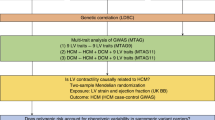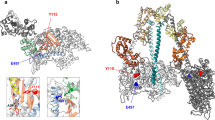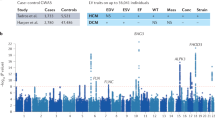Abstract
Familial hypertrophic cardiomyopathy (FHC) is, in most cases, a disease of the sarcomere, caused by a mutation in one of 10 known sarcomere disease genes. More than 266 mutations have been identified since 1989. The FHC disease gene first characterized MYH7, encodes the cardiac β-myosin heavy chain, and contains more than 115 of these mutations. However, in most studies, only the region encoding the globular head and the hinge region of the mature cardiac β-myosin heavy chain have been investigated. Furthermore, most studies carries out screening for mutations in the most prevalent disease genes, and discontinues screening when an apparent disease-associated mutation has been identified. The aim of the present study was to screen for mutations in the rod region of the MYH7 gene in all probands of the cohort, regardless of the known genetic status of the proband. Three disease-causing mutations were identified in the rod region in four probands using capillary electrophoresis single-strand conformation polymorphism as a screening method. All mutations were novel: N1327K, R1712W, and E1753K. Two of the probands had already been shown to carry other FHC-associated mutations. In conclusion, we show that in the Danish cohort we find one third of all MYH7 mutations in the rod-encoding region and we find that two of the patients carrying these mutations also carry mutations in other FHC disease genes stressing the need for a complete screening of all known disease genes in FHC-patients.
Similar content being viewed by others
Log in or create a free account to read this content
Gain free access to this article, as well as selected content from this journal and more on nature.com
or
References
Maron BJ, Gardin JM, Flack JM, Gidding SS, Kurosaki TT, Bild DE : Prevalence of hypertrophic cardiomyopathy in a general population of young adults. Echocardiographic analysis of 4111 subjects in the CARDIA Study. Coronary Artery Risk Development in (Young) Adults. Circulation 1995; 92: 785–789.
Fung DC, Yu B, Littlejohn T, Trent RJ : An online locus-specific mutation database for familial hypertrophic cardiomyopathy. Hum Mutat 1999; 14: 326–332.
Blair E, Redwood C, de Jesus OM et al: Mutations of the light meromyosin domain of the beta-myosin heavy chain rod in hypertrophic cardiomyopathy. Circ Res 2002; 90: 263–269.
Richard P, Charron P, Carrier L et al: Hypertrophic cardiomyopathy: distribution of disease genes, spectrum of mutations, and implications for a molecular diagnosis strategy. Circulation 2003; 107: 2227–2232.
Bundgaard H, Havndrup O, Andersen PS et al: Familial hypertrophic cardiomyopathy associated with a novel missense mutation affecting the ATP-binding region of the cardiac beta-myosin heavy chain. J Mol Cell Cardiol 1999; 31: 745–750.
Andersen PS, Havndrup O, Bundgaard H et al: Adult-onset familial hypertrophic cardiomyopathy caused by a novel mutation, R694C, in the MYH7 gene. Clin Genet 1999; 56: 244–246.
Havndrup O, Bundgaard H, Andersen PS et al: A novel missense mutation, Leu390Val, in the cardiac beta-myosin heavy chain associated with pronounced septal hypertrophy in two families with hypertrophic cardiomyopathy. Scand Cardiovasc J 2000; 34: 558–563.
Havndrup O, Bundgaard H, Andersen PS et al: The Val606Met mutation in the cardiac beta-myosin heavy chain gene in patients with familial hypertrophic cardiomyopathy is associated with a high risk of sudden death at young age. Am J Cardiol 2001; 87: 1315–1317.
Andersen PS, Havndrup O, Bundgaard H et al: Genetic and phenotypic characterization of mutations in myosin-binding protein C (MYBPC3) in 81 families with familial hypertrophic cardiomyopathy: total or partial haploinsufficiency. Eur J Hum Genet 2004; 12: 673–677.
Andersen PS, Havndrup O, Bundgaard H et al: Myosin light chain mutations in familial hypertrophic cardiomyopathy: phenotypic presentation and frequency in Danish and South African populations. J Med Genet 2001; 38: E43.
Havndrup O, Bundgaard H, Andersen PS et al: Outcome of clinical versus genetic family screening in hypertrophic cardiomyopathy with focus on cardiac beta-myosin gene mutations. Cardiovasc Res 2003; 57: 347–357.
Andersen PS, Jespersgaard C, Vuust J, Christiansen M, Larsen LA : High-throughput single strand conformation polymorphism mutation detection by automated capillary array electrophoresis: validation of the method. Hum Mutat 2003; 21: 116–122.
Richard P, Isnard R, Carrier L et al: Double heterozygosity for mutations in the beta-myosin heavy chain and in the cardiac myosin binding protein C genes in a family with hypertrophic cardiomyopathy. J Med Genet 1999; 36: 542–545.
Poetter K, Jiang H, Hassanzadeh S et al: Mutations in either the essential or regulatory light chains of myosin are associated with a rare myopathy in human heart and skeletal muscle. Nat Genet 1996; 13: 63–69.
Author information
Authors and Affiliations
Corresponding author
Rights and permissions
About this article
Cite this article
Hougs, L., Havndrup, O., Bundgaard, H. et al. One third of Danish hypertrophic cardiomyopathy patients have mutations in MYH7 rod region. Eur J Hum Genet 13, 161–165 (2005). https://doi.org/10.1038/sj.ejhg.5201310
Received:
Revised:
Accepted:
Published:
Issue date:
DOI: https://doi.org/10.1038/sj.ejhg.5201310
Keywords
This article is cited by
-
MYH7 in cardiomyopathy and skeletal muscle myopathy
Molecular and Cellular Biochemistry (2024)
-
Cardiac sarcomere mechanics in health and disease
Biophysical Reviews (2021)
-
Pseudophosphorylation of cardiac myosin regulatory light chain: a promising new tool for treatment of cardiomyopathy
Biophysical Reviews (2017)
-
Molecular mechanisms of cardiomyopathy phenotypes associated with myosin light chain mutations
Journal of Muscle Research and Cell Motility (2015)
-
Hypertrophic Cardiomyopathy: A New Mutation Illustrates the Need for Family-Centered Care
Pediatric Cardiology (2014)



